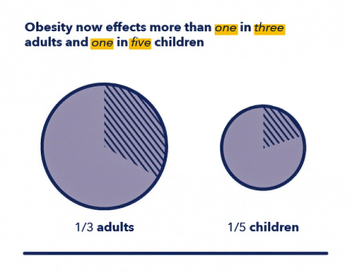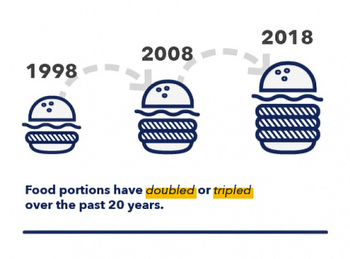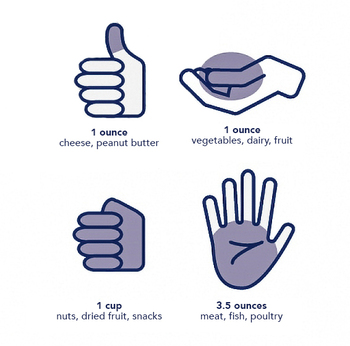According to the Centers for Disease Control and Prevention (CDC), obesity affects more than one-third of adults and one in five children in the U.S. This trend is associated with a combination of the amount of food we eat and a decline in physical activity—we gain weight when we eat more calories than we burn.

A key contributor to this imbalance is oversized food portions. Over the past 20 years, U.S. food portions have doubled or tripled, making it easier than ever to overeat. When we order meals in restaurants, there's often enough food for two or even three people.

It can be challenging to determine appropriate portion sizes when we’re used to seeing massive sandwiches and huge side dishes. This “portion distortion” affects what we think of as normal portion sizes when we cook at home, too.
Although our food portions are much larger today than they used to be, it doesn’t mean we need to eat everything just because it’s in front of us. You can battle the tendency to overeat by working with a registered dietitian and by following three easy tactics to control your calorie intake and make healthier food choices.
3 Strategies to Control What You Eat
1. ChooseMyPlate
The United States Department of Agriculture (USDA) offers the ChooseMyPlate website, which provides a visual example of what a healthy meal should include for most Americans. You can use the visual aid to plan meals, eat out, or cook at home.
The plate is divided into the five healthy food groups—fruits, vegetables, grains, protein, and dairy. Ideally, half of the plate should be fruits and vegetables, one-quarter should be a lean protein, and the final quarter should be grains. Dairy is shown as a side cup or dish next to the plate. ChooseMyPlate also offers recommended daily amounts for each food group, all of which vary based on an individual’s unique nutrition needs and level of physical activity.
Below are some guidelines to think about when you use ChooseMyPlate:
- Vegetables: Any type of vegetable or 100 percent vegetable juice. Fresh vegetables—cooked or raw—are recommended, but canned, pureed and frozen are acceptable as well.
- Fruits: Any fruit or 100 percent fruit juice. Like vegetables, fruits can be fresh, canned, pureed or frozen, and also can be dried.
- Proteins: Lean meat, lean poultry, seafood, beans and peas, eggs, processed soy products, nuts, and seeds. Red meat is recommended just every now and then.
- Grains: Foods made from wheat, rice, oats, cornmeal, barley or other grains. Common foods in this group include bread, pasta, oatmeal, cereal, tortillas, and grits. At least half of the grains you eat should be whole grains.
- Dairy: Milk and many foods made from dairy are considered part of this food group if they have calcium. Eligible foods include yogurt, cottage cheese, and calcium-fortified soymilk. Dairy products that don’t have calcium are not included in this group, such as cream, butter, and cream cheese.
2. Measure With Your Hands
A recommended serving size is the amount of each food you should eat during a meal or snack, while a portion is the amount of food that you actually eat. If you eat more than the recommended serving size, you likely will get too many calories or too much of a certain nutrient.
An easy solution is to measure the food we eat. But how can you determine a proper serving without specific measuring tools? You can use your hand and fingers to measure appropriate food portions.
Use this cheat sheet for estimating portions of specific foods: 
- Your closed fist is about the size of one cup
-
- Vegetables
- Milk or yogurt
- Cooked rice, pasta, or cereal
- Fruit, raw or cooked
- Fruit juice can be one-half cup, or half a fist
- Leafy salad greens can be 2 cups, or the size of two fists
- A handful is about an ounce
-
- Nuts or dried fruits, such as raisins
- Larger snacks, such as chips, pretzels, or popcorn can be about two handfuls
- Your palm is roughly equivalent to 3 to 5 ounces
While it’s not an exact science, this method can help you keep proper portion sizes in mind wherever you go. For example, if you get a piece of chicken at a restaurant that’s the size of both your palms, cut it in half and share it or save the other half for tomorrow’s lunch. You can train your brain to avoid portion distortion. Every now and then, measure your favorite foods on a food scale as well so you can have a visual of the appropriate portion size.
3. Read Your Food Labels
Many of us grew up starting our mornings by pouring a heaping pile of cereal into a bowl. How much cereal we ate depended largely on the size of our bowl. However, many cereals suggest a serving size of less than a cup, and many of us eat much more than that in a sitting.
We all need to understand food labels, not only to learn the recommended serving size, but also to use the nutrition information in the context of our entire day. The nutritional elements included in the label, such as total carbohydrates, sodium, or sugar are suggested amounts in the context of a serving size.
If we have double the serving of cereal, for example, we’ll eat double the amount of sugar or sodium listed on the food label. Use these tips when reading food labels and incorporate the recommendations into your daily food intake:
- Check the serving size. Sometimes more than one serving is listed.
- Follow the USDA’s 2015-2020 Dietary Guidelines for Americans Unless otherwise directed by your doctor or dietitian, eat and drink:
- Less than 10 percent of calories per day from added sugars.
- Less than 10 percent of calories per day from saturated fats.
- Less than 2,300 milligrams (mg) per day of sodium.
- Pay attention to the order of food ingredients. They’re listed in order of quantity, from greatest to least. Keep in mind that just because something is far down the list doesn’t mean there’s just a little of it. For example, tomatoes may be the most prevalent item in salsa, but it might have a lot of sodium, even if salt is the last ingredient listed.
- Check how many ingredients are in the food. A long list of ingredients may be a sign of artificial additives.
- Understand the daily recommended amounts of ingredients. Using sodium as an example again, the recommended daily amount for adults without health complications is just 2,300 mg per day, or just a little more than one teaspoon. The percent of daily value number on the label is an easy way to see how much of a day’s worth of a certain nutrient is in the food you’re about to eat.
- Eat foods that don’t have labels. In other words, opt for whole foods, such as fresh fruits and vegetables, more often than processed foods.
Use these tips to beat portion distortion at home and while eating out. If you need a little extra help, consider working with a registered dietitian to get your nutrition on the right track. Before you know it, portioning, choosing healthy foods and reading food labels will become second nature.
Want to learn more about how we can help you live a healthy life?
Click the button below to view the list of our services.
Learn More